Kisatchie Wild Horses
Here is nearly everything to know about the Horses that range on Ft. Polk's hundreds of thousands of acres and in the Kisatchie National Forest:
Section I. The Horses
The most important thing is understanding that the horses aren't all the same.
[In west-central Louisiana, between Alexandria and Leesville, there are units of the Kisatchie National Forest [KNF], and two principal areas of Ft. Polk: Ft. Polk proper, the Peason Ridge area, and other areas recently acquired that very significantly increases the lands that Ft. Polk owns. The new lands fill-in between the two principal areas that are about 12 miles, or so, apart. One unit of the KNF adjoins the Peason Ridge area, and it includes the "Red Dirt Wilderness" within it.]

The wild horses in the Peason Ridge area have the appearance and behavioral characteristics of truly wild horses that have been in the area for a very long time. These are the horses that it is essential to preserve and protect.
Wild horses on Peason Ridge:
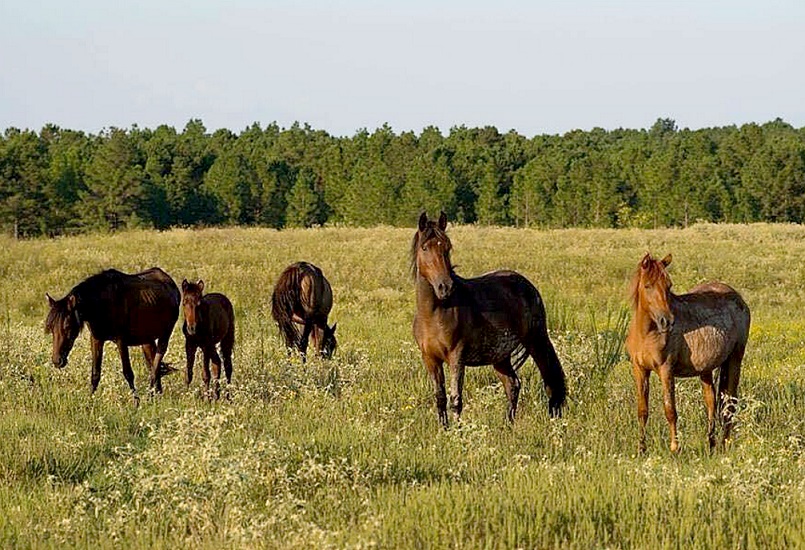
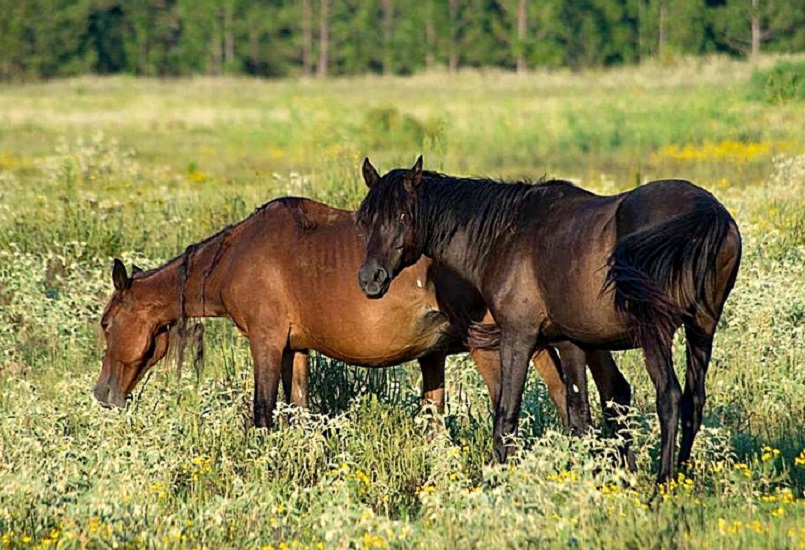

The horses on Ft. Polk proper have different appearances. Some appear to be bands of wild horses like those on Peason Ridge. Others, have various appearances, including gray and white horses, which do not appear on Peason Ridge. Whether these horses are wild is a matter of definition, some of their number have resulted from people "dumping" horses at Ft. Polk over the years. For most, they certainly have the behaviors of wild horses: small bands under the leadership of a dominant stallion. But, unlike the horses on Peason Ridge that avoid people and won't even eat hay set out for them, the horses on Ft. Polk proper are used to being around people, and are not deterred by Army operations. Consequently, there are sometimes horses in the Geronimo Parachute Drop Zone that soldiers have to avoid (there has never been an accident involving a horse), and soldiers on bivouac have awakened to horses in their midst and horse droppings they had to avoid while on marches. The Army may reference one unusual incident where a horse got out of the training area because they intentionally left the gates open, and the horse was hit on the highway by an RV. I directly asked the commander's secretary about horse-related incidents, and she said there were two nuisance incidents that she could remember, but never an actual accident on base regarding a horse. We do need to accommodate the Army regarding potential horse-related risks.
Wild horses on Ft. Polk (Main):
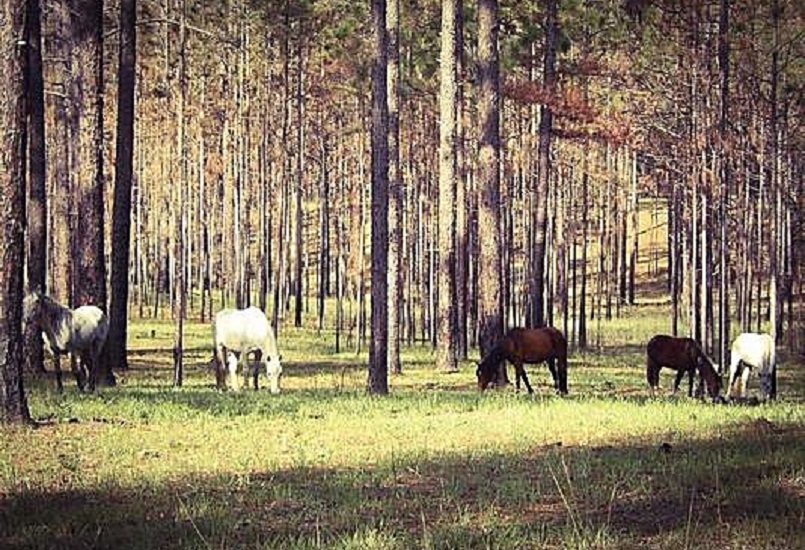
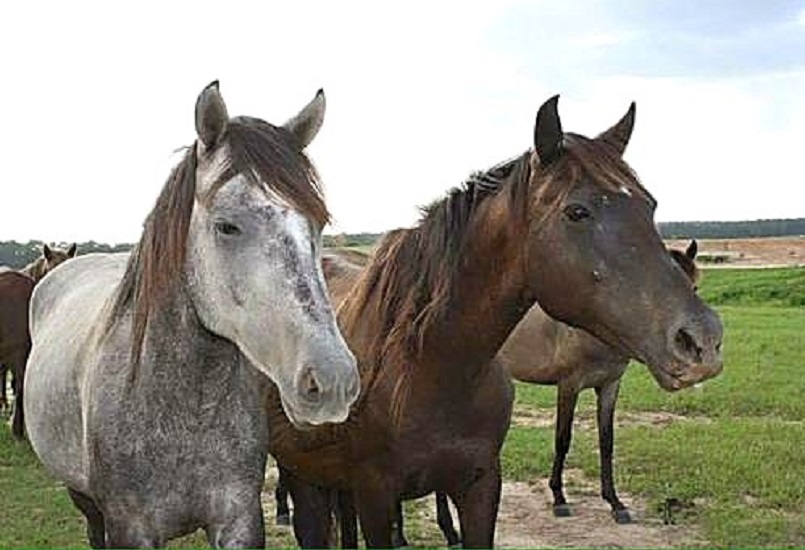
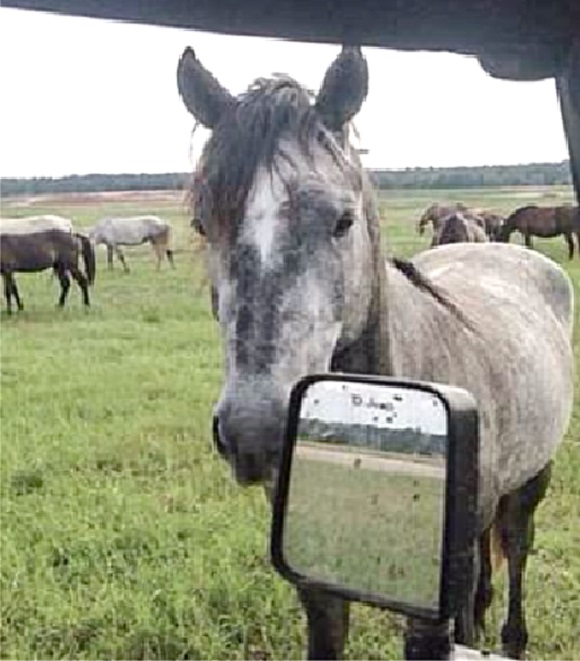
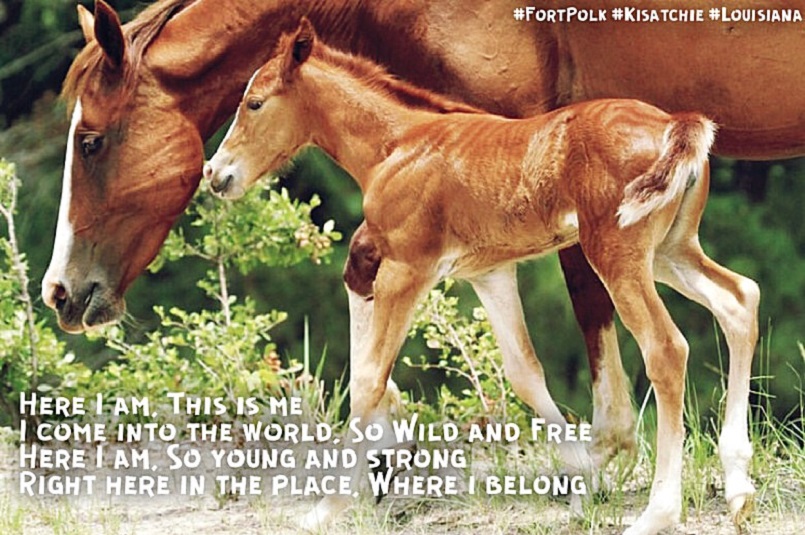
The Peason Ridge area includes a "hot" (live ordinance) training area. When the shooting or detonations start, the horses go into the woods for cover. During training, "concertina" razor wire is put out. The wire is supposed to be retrieved after training exercises end, but it has (apparently) been routinely left on the training area. Horses have gotten cut by the wire.
However, all things considered (including the various natural hazards that wild horses encounter: rough terrain, poisonous snakes, mountain lions, etc., and destructive, lethal acts by malicious people), the horses are probably safer, or at least as safe, in that environment as wild horses anywhere.
Ft. Polk says they need all of their land for training, and they anticipate more extensive usage. But, according to a knowledgeable source, the Army has made an agreement with a former owner (a timber company), concerning the land recently acquired from them, not to use the area for ten years; at which point the company can harvest the timber. Part of that land could be used for temporarily holding some of the horses. And, there has been less training activity, not more. Soldiers were adequately accommodated on the lands before the new acquisitions, and that included training activities for the Vietnam War and Operation Desert Storm.
There has been an on-going problem where horses have been illegally taken from Ft. Polk lands. There is a degree of general lawlessness at Ft. Polk: out-in-the-open drug dealing (according to Public Affairs Officer Troy Darr) and extensive illegal "hunting" where arrests were made by LDW&F agents, in addition to horse stealing. There are indications that "kill buyers" who normally acquire horses at auction to sell them into the "slaughter pipeline" are operating at Ft. Polk. It appears that known "kill buyers" applied to take horses in Ft. Polk's program that allowed individuals to take horses.
There needs to be some non-military law enforcement at Ft. Polk, with agents working to control the lawlessness, and to protect the horses.
Section II. How the Horses Have Been Regarded By People
The horses are loved by many people in the area and elsewhere who don't want to see them gone.
One young woman who lives on Ft. Polk said: "I feel upset about them being removed. They are so beautiful! They don't harm anyone, and they were here before us. They bring joy to a lot of folks here. It's what Fork Polk is known for!"
A former Ft. Polk commander, General Samuel Thompson, strongly expressed his desire to keep the horses. In May, 1999, he wrote: "I don't want to lose those herds."
To suit the desire of those who have sought to get rid of the horses, Ft. Polk officials have used every ploy they can think of to vilify the horses: they may carry disease, etc. But, their main ploy is to declare that they are not wild horses. They say (publicly) the horses are "trespass horses". Actually, I recently saw an official Ft. Polk telephone directory on the Internet that had a notation next to one of the phone numbers under the Office of Public Affairs saying "wild horses".
I first heard that concocked term, "trespass horses", at a meeting organized to brief me at Ft. Polk about 15 years ago. I had a very good working relationship with the Public Affairs Officer at that time: Dan Nance.
The person most responsible for working, over the years, toward getting rid of the horses was at that meeting. He, Wayne Fariss, was a civil service employee in Ft. Polk's environmental science team. He has recently been promoted to Chief Range Manager. There is on record a statement by another Ft. Polk employee saying that Wayne Fariss was the only one against the horses. Here are two statements by him:
In answer to Question 20 (anything to add) C.J. McCann states, "I think they add to the atmosphere of the training area and they are part of nature and they don't bother anyone. They don't let you get close to them. I don't know of anyone hitting one with a vehicle and they don't interfere with the aircraft. Some people have tried to feed them but they won't eat.
[He is apparently talking about the horses on Peason Ridge.]
In answer to Question 26 (regarding complaints) C.J. McCann states, "I have never heard anyone complain about them except for Wayne Farris."
[This is an interesting statement since Wayne Fariss is the post official who was most responsible for producing the Environmental Assessment at that time. It tends to cast doubt upon the impartiality of the report.]
Col. Francis Burns, then Ft. Polk commander, in resolving the EA, chose Option 2, which would require testing for EIAV (the virus that causes Equine Infectious Anemia) exposure and sterilization as population control. Incidentally, at that time, Wayne Fariss said: "I do not think in general that the population has increased."
Seven horses were captured and Coggins tested. None tested positive.
Wayne Fariss got an ally in the previous Ft. Polk Commander, Lt. Gen. Timothy McGuire who wanted to "modernize" Ft. Polk. He was there just long enough to push a new Environmental Assessment [EA]. Normally, an EA includes various options for solving the problem being addressed - from the least impact (usually do nothing), to the most. The EA didn't really include a "no action" option, because Ft. Polk had a program in effect where individuals were allowed to come and remove horses from Ft. Polk. And, all of the options were toward removal of the horses. There was no spectrum of options (the normal situation); only different options for getting rid of the horses, including "euthanasia" (as I recall, but I'd have to look it up to verify that).
Gen. McGuire met with a group of people who later gelled into the Pegasus Equine Guardian Association [Pegasus]. But, it was apparent that his mind was pretty much already made up.
Gen. McGuire was sent to command our Army forces in Europe, and Brigadier General Gary Brito took over at Ft. Polk. Troy Darr said Gen. McGuire was a really hard and tough warrior, but he had a gentle regard for the horses.
Gen Brito came in as a very conscientious and public-minded leader. He has volunteered in the community to help at the school, etc., and he has held meetings to communicate with the public, and to give orientation to his newer Ft. Polk people.
I started communicating with Gen. Brito many weeks before he actually assumed command. I had arranged a meeting between Gen. Brito and Rickey Robertson, a reverend, and local historian who had good relationships with former Ft. Polk commanders. He is a member of the "Heritage Families" who were displaced when Ft. Polk was established in 1941. Rev. Robertson is also a member of Pegasus. But, he met with General Brito only as himself to, among other things, discuss the horses.
I asked General Brito if he would be amenable to discussing the horses at one of his public meetings, but I was denied by Garrison Commander Col. Greg Athey, who has acted as Ft. Polk spokes person on the matter of the horses. Col. Athey recently informed me that the matter about the horses is closed. And, Gen. Brito, who was always cordial in our e-mail communications, has stopped communicating with me personally.
Section III. History
My involvement with the horses goes back to a campaign I was waging regarding the policy of the LDAF to eliminate all horses that tested positive for EIAV, the virus that causes Equine Infectious Anemia ("swamp fever"). I communicated with people who were told they had to destroy their horses, and with the key scientists (including Leroy Coggins, Charles Issel, and USDA APHIS Veterinary Services Dr. Tim Cordes). I was well-versed. Then, a member of Bob Odom's Livestock Sanitary Board started a "witch hunt" regarding the Ft. Polk horses. The LDAF said the horses were a "reservoir of EIA infection" that threatened owned horses. This was a fabrication. Six horses were captured, and one foaled after capture. None of them tested positive. Louisiana State Representative Warren Triche got a joint resolution passed in 2004 (which I had written) to say the horses ought to be protected.
[See:
http://humaneheart.org/horses/resolution.pdf]
As then president of the Coalition of Louisiana Animal Advocates, I got the Tulane Environmental Law Clinic to file a lawsuit to have the horses declared wild horses under the protection of the federal government. The district court would not assent to the petition, and the court of appeal confirmed the lower court's ruling. At that time little was known about the horses, except that they did range on Ft. Polk lands. One of the court of appeal judges asked if there were pictures of the horses, to which the assistant U.S. attorney said there were not. I was shown pictures of the horses at my Ft. Polk briefing, and I had some in my possession at the court of appeal hearing. I set the record straight with the judge after the fact. There was a settlement, to which the government (the Army at Ft. Polk) never complied. When I was at Ft. Polk, Mr. Nance took me out via military helicopter to actually observe a band of the horses.
Section IV. What's Needed
Most importantly: The first order of business is to get the Army to put its horse removal program on hold, and allow us to work with them for the preservation and protection of the horses.
Secondarily, there needs to be managed sanctuaries for the horses, and general law enforcement.
For the long term: Since the courts were not helpful in saving the horses, approaching Congress to officially recognize our Louisiana wild horses under the Wild Free-roaming Horses and Burros Act of 1971 is desirable. There is a bill by Rep. Walter Jones (R-NC) in the U.S. Senate, that has already passed in the House, to give similar protection to wild horses that inhabit the "outer banks" island of Corolla, North Carolina. [I have already spoken with one of Rep. Jones' assistants, and sent him extensive information about our Louisiana wild horses.]
Wild horses on the "Outer Banks" Island of Corolla:

Notice (below) how the horses, even though they are truly wild horses, have become accustomed to being in the presence of people, just as are the horses on Ft. Polk (main). Perhaps more of the horses on Ft. Polk (main), previously presumed domesticated, are wild horses, too. Notice the similarity of the two horses in the second picture under Ft. Polk (main) above. The conformation of their heads is the same, and unlike other breeds of horses.

I think there are potential tourism opportunities in west-central Louisiana based upon observation of the horses. There is tourism based on wild horses elsewhere, including the North Carolina Corolla horses, and mustangs in Nevada and the Prior Mountain Wild Horse Range in Montana, all with visitors centers. Recall the documentary about one of the Prior Mountain horses: "Cloud".
Wild Horses of Prior Mountain:
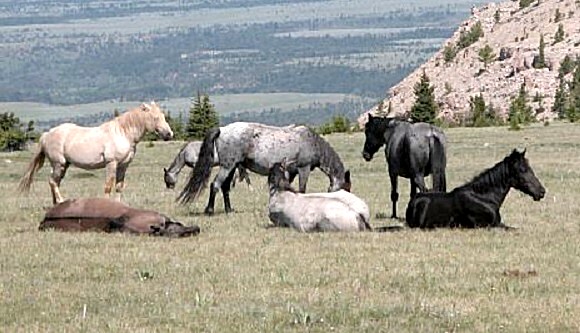
Our Louisiana wild horses on Peason Ridge look consistently alike. They are in appearance more like true wild horses than those on Prior Mountain. The Corolla horses also look very much alike. They have been where they are for centuries.
Pinckney Wood
(865) 383-4033
p.a.wood@juno.com